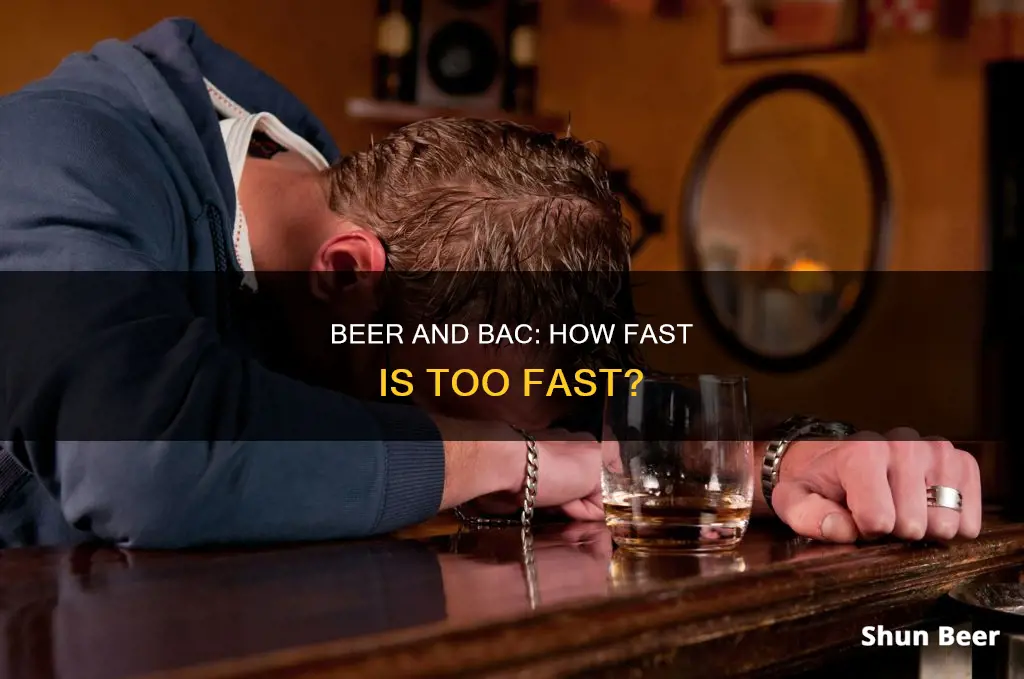
Drinking several beers in quick succession can indeed cause your blood alcohol concentration (BAC) to rise faster. The speed at which alcohol enters your bloodstream and impacts your system depends on several factors, including the quantity and speed of consumption, as well as individual characteristics like weight, body fat percentage, and stomach content. The liver, which is responsible for metabolizing alcohol, works at a constant rate of approximately one drink per hour. Therefore, drinking multiple beers in a short period can lead to a higher BAC as the liver struggles to keep up with the rate of alcohol consumption. Additionally, consuming alcohol on an empty stomach allows it to pass into the small intestine more rapidly, increasing the speed of absorption into the bloodstream and intensifying the effects.
| Characteristics | Values |
|---|---|
| How quickly does drinking several beers affect your BAC? | Drinking several beers in quick succession will affect your BAC more than drinking the same amount of beer over a longer period. |
| How does drinking speed affect BAC? | Drinking speed affects BAC as the body needs time to process the alcohol. Drinking faster adds alcohol to your system more quickly than your body can process it. |
| How does drinking on an empty stomach affect BAC? | Drinking on an empty stomach means there is no food to slow the passage of alcohol into the small intestine, where it is absorbed faster. This intensifies the effects of alcohol and makes them come on faster. |
| How does carbonation affect BAC? | Carbonated alcoholic drinks increase the rate of alcohol absorption. The pressure in the stomach and small intestine forces alcohol to be absorbed more quickly into the bloodstream. |
| How does weight affect BAC? | The more you weigh, the more space alcohol has to spread out, resulting in a lower BAC. |
What You'll Learn

Drinking on an empty stomach
The faster absorption of alcohol when drinking on an empty stomach intensifies all the side effects of drinking, such as difficulty with thinking and coordination. It can also lead to unpleasant and toxic side effects, including gastritis and other stomach problems, loss of coordination, reduced responsiveness, uncontrolled eye movements, and tachycardia (rapid heartbeat).
If you are drinking on an empty stomach, it is important to pace yourself, drink water between alcoholic drinks, and know your limits. Eating at least an hour before drinking can also help to slow down the absorption of alcohol and reduce your BAC. Consuming foods that are high in fat and protein, such as cheese, nuts, and meats, can be particularly effective in slowing down alcohol absorption.
Beer and Zoloft: Is It Safe to Drink Alcohol?
You may want to see also

Carbonated drinks
A study by researchers in England found that the blood alcohol levels of people drinking bubbly Champagne were higher for the first 20 minutes, compared to those drinking a degassed one, suggesting that the alcohol entered the bloodstream quicker. However, this effect wore off about 35 minutes after consumption. A similar study from Manchester, England, found that adding a carbonated mixer to vodka increased the initial rate of alcohol absorption into the blood by about 50% on average. However, this rate varied among the volunteers, and some subjects absorbed the bubbly cocktail more slowly or showed no difference.
The speed at which you drink also affects your BAC. Drinking a glass of wine in a hurry will make you feel drunker than if you spread sips out over an hour. Similarly, chugging a drink will get more alcohol into your body faster than sipping it.
Beer Benefits for Hair: A Guide
You may want to see also

Gender differences
Physiological Differences
Females have less body water to dilute alcohol, resulting in a higher concentration of blood alcohol. They also typically have higher body fat, and fat retains alcohol.
Alcohol Metabolism
Females metabolize alcohol at a different rate than males, even if they weigh the same. Men are able to metabolize alcohol faster because they have higher levels of an enzyme called alcohol dehydrogenase (ADH) in their stomach and liver.
Drinking Patterns
Among adolescents, there are no significant differences in experimental drinking between boys and girls. However, as they enter young adulthood, boys are more likely to develop disruptive drinking habits due to a low response to alcohol, later maturation in brain structures, and greater estimates of perceived peer alcohol use.
Among adults, alcohol use is increasing for women but not for men. Rates of alcohol-related emergency department visits, hospitalizations, and deaths have all increased among adults over the past two decades, with larger increases for women.
Alcohol-Related Harms
Recent studies suggest that females are more susceptible than males to alcohol-induced liver inflammation, cardiovascular disease, memory blackouts, hangovers, and certain cancers.
Treatment
Differences in the influence of gonadal steroid hormones, neurotransmitter systems, patterns of behavior, increased brain and organ damage in women, and a variety of other factors need to be taken into consideration when treating alcohol-dependent patients.
Morphine and Beer: A Dangerous Mix?
You may want to see also

Food in the stomach
The presence of food in the stomach acts as a barrier, slowing down the rate at which alcohol passes into the small intestine. This delay in absorption results in a lower blood alcohol concentration (BAC). Studies have shown that a person who drinks on an empty stomach can have a BAC up to three times higher than someone who has eaten beforehand. Eating food, especially protein-rich food, before drinking can effectively prevent a person from getting drunk too quickly.
The type of food consumed also influences the absorption rate. Protein has the most significant effect on reducing BAC, followed by carbohydrates. Fatty foods, on the other hand, are relatively ineffective in lowering BAC, regardless of the quantity consumed. Therefore, it is advisable to opt for meals consisting mainly of protein and carbohydrates while limiting fat intake.
The timing of food consumption in relation to drinking is another critical factor. Eating a meal within half an hour before drinking has been found to provide the greatest reduction in BAC. The effect of food on BAC gradually decreases over time, becoming negligible after two hours. Even small amounts of food consumed within this time frame can help lower BAC compared to drinking on an empty stomach.
In summary, consuming food, particularly protein-rich meals, within close proximity to drinking alcohol can substantially reduce BAC. This delay in absorption allows the body to process alcohol at a slower rate, reducing the risk of becoming intoxicated too quickly.
Colonial Kids and Beer: A Historical Perspective
You may want to see also

Tolerance to alcohol
There are several types of alcohol tolerance:
- Functional Tolerance: This occurs when the brain functions of drinkers adapt to compensate for the disruption that alcohol causes in their behavior and bodily functions. This can result in physical dependence and organ damage.
- Acute Tolerance: This is when a drinker develops a tolerance to the effects of alcohol during a single drinking session. They may appear more intoxicated at the beginning of the session than at the end.
- Environment-Dependent Tolerance: Alcohol tolerance can be accelerated if drinking always takes place in the same environment or is accompanied by the same cues.
- Environment-Independent Tolerance: This occurs when functional tolerance to alcohol develops independently of environmental influences, following exposure to large quantities of alcohol.
- Metabolic Tolerance: This occurs when a specific group of liver enzymes is activated after a period of chronic drinking, resulting in a more rapid elimination of alcohol from the body. This can lead to liver damage and affect the metabolism of other drugs and medications.
Beer and Methotrexate: What's Safe to Drink?
You may want to see also
Frequently asked questions
Yes, drinking faster can certainly make you become drunker than you would be otherwise. How quickly you add alcohol to your system and allow your body to process it does make a difference in your blood alcohol content.
Your body absorbs alcohol into your bloodstream much faster when you drink on an empty stomach. Blood Alcohol Concentration (BAC) peaks about 1 hour after you drink on an empty stomach.
The type of drink you consume makes a difference, too. Carbonated drinks, such as champagne or a whiskey soda, enter your system faster. This means that those drinks will generally lead to a higher BAC sooner.







